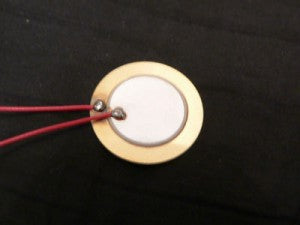Bascom King, the man now designing our new power amplifier, has worked on servo systems since the 'early days'. After using expensive aerospace accelerometers to measure woofer movement for Infinity, Bascom came up with the idea of mounting a low cost piezo electric disc to the edge of the woofer's voice coil instead. It was a rather clever approach.
Bascom took a bifurcated shaft (think the end of an arrow that meets the string of a bow) and mounted it to the edge of the voice coil former, pointing toward the listener. On the other end of the shaft he glued the center of the piezo element. The entire affair was hidden behind the woofer's dust cap. That was it. As the woofer moved back and forth it would flex the piezo crystal and produce a voltage, proportional to the woofer's movement. It was an accelerometer.
Here's a picture of a similar piezo element.

if you take the output of an accelerometer and integrate it, (run it through a low pass filter), you get a duplicate of the movement of the woofer, which is the end goal.
Now this all sounds very technical and I suppose it is. But from a practical sense it is easy to execute. So easy, in fact, I am surprised every subwoofer made does not have a servo to it. I'll get into this more as we go along. First, let's discuss the advantages of a servo woofer. There are many.
Attaching a servo to a woofer gives the woofer:
- Perfect frequency response.
- Corrects the rise time limitations we discussed because of the woofer's mass.
- Solves the overhand problem (where the woofer keeps going forward after it's told to go the other direction).
- Lowers distortion on the output.
- Extends the frequency range.
- Helps it integrate with any speed main loudspeaker (i.e. electrostats or ribbons).
- Allows it to produce near perfect square waves at low frequencies (compared to the ugly outcomes of a non-servo woofer).
There may be more, but that's a lot. No other system I know of can come close.
There are those engineers that claim one can equalize a woofer to have the same characteristics, but in fact, that is not true. Only a feedback system using a servo achieves the laundry list of benefits I described.
A servo system cannot makeup for the following:
- Poor cone design
- Breakup modes
- Cabinet issues
- Lack of amplifier power
- Limited excursion of the driver
But those are things any competent woofer designer should be capable of addressing.
Here's another requirement for building a proper woofer with motional feedback control: lots of amplifier power.
I mentioned a servo can produce perfect frequency response in any size enclosure, extending that response as low as the designer wants. What I didn't mention is what it takes to do that. There's a point in any woofer system where the size of the woofer enclosure is too small for the woofer itself. That point is called the box resonance. Below that point, the woofer rolls of quickly and we get no more bass on the box output unless we force the woofer to really pump out more bass.
Let's imagine that point in our box is 60Hz. If we want our servo controlled woofer to go down to 30Hz, it will do so automatically if there's enough power. For every octave we wish to produce below the resonance of the box we need four times the power to do so. That means if we start with a 50 watt power amplifier on our woofer, we can easily produce bass down to 60Hz. To produce 30Hz we'll need 200 watts out of our amp and to produce 15Hz, we'll need 800 watts. It goes up quickly.
Tomorrow let's see how easy it is to add a servo and then ask the question that's burning in all our minds.
 if you take the output of an accelerometer and integrate it, (run it through a low pass filter), you get a duplicate of the movement of the woofer, which is the end goal.
Now this all sounds very technical and I suppose it is. But from a practical sense it is easy to execute. So easy, in fact, I am surprised every subwoofer made does not have a servo to it. I'll get into this more as we go along. First, let's discuss the advantages of a servo woofer. There are many.
Attaching a servo to a woofer gives the woofer:
if you take the output of an accelerometer and integrate it, (run it through a low pass filter), you get a duplicate of the movement of the woofer, which is the end goal.
Now this all sounds very technical and I suppose it is. But from a practical sense it is easy to execute. So easy, in fact, I am surprised every subwoofer made does not have a servo to it. I'll get into this more as we go along. First, let's discuss the advantages of a servo woofer. There are many.
Attaching a servo to a woofer gives the woofer:








